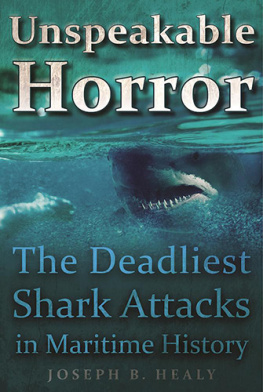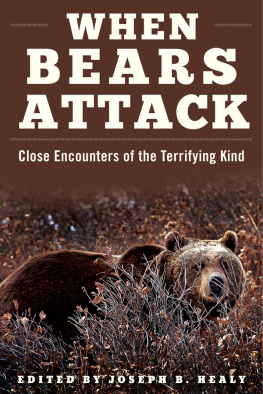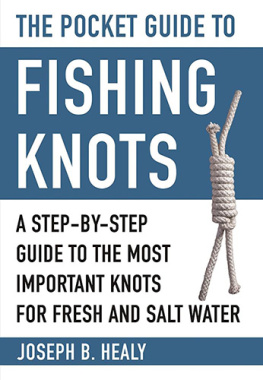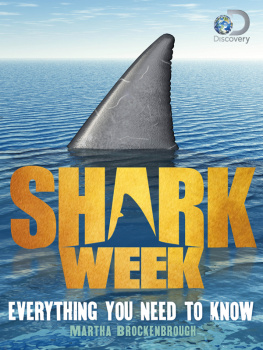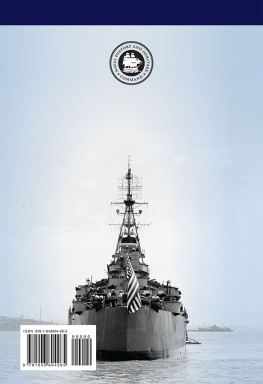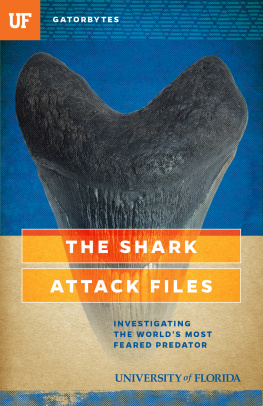All stories copyright 2017 by Joseph B. Healy
Except, printed with permission: The Pig Basket Atrocity Stephen H. Foreman, 2016; MV Dona Paz and Requiem Sharks Stephen H. Foreman, 2016; Murder by Shark at Cheribon Stephen H. Foreman, 2016; Blackfish and Hammerheads of Barrouallie Stephen H. Foreman, 2016; Sharkman Jerry Gibbs, 1990, originally published in Steel Barbs, Wild Waters , used by permission.
All rights reserved. No part of this book may be reproduced in any manner without the express written consent of the publisher, except in the case of brief excerpts in critical reviews or articles. All inquiries should be addressed to Skyhorse Publishing, 307 West 36th Street, 11th Floor, New York, NY 10018.
Skyhorse Publishing books may be purchased in bulk at special discounts for sales promotion, corporate gifts, fund-raising, or educational purposes. Special editions can also be created to specifications. For details, contact the Special Sales Department, Skyhorse Publishing, 307 West 36th Street, 11th Floor, New York, NY 10018 or .
Skyhorse and Skyhorse Publishing are registered trademarks of Skyhorse Publishing, Inc., a Delaware corporation.
Visit our website at www.skyhorsepublishing.com.
10 9 8 7 6 5 4 3 2 1
Library of Congress Cataloging-in-Publication Data is available on file.
Cover design by Tom Lau
Cover photo credit: iStockphoto
Print ISBN: 978-1-5107-1935-4
Ebook ISBN: 978-1-5107-1936-1
Printed in the United States of America.
CONTENTS
By Jack London
By Stephen H. Foreman
By Stephen H. Foreman
By Stephen H. Foreman
By Stephen H. Foreman
By Jerry Gibbs
The shark is natures perfect design for survival in the sea.
Robert Reid, in Shark!: Killer Tales from the Dangerous Depths
It wasnt the jaws that mesmerized me, it was those protrusions on either side of its head. They belonged to a creature to whom I was nothing but an easy kill.
Stephen H. Foreman, describing a hammerhead shark in Blackfish and Hammerheads of Barrouallie
INTRODUCTION: CONTEMPLATING MASS DEATH AT SEA
Thoughts on Unspeakable Horror: The Worst Shark Attacks in Maritime History
By Joseph B. Healy
T he story of the USS Indianapolis from World War II is well known and gets a fair representation in this book. Captain Quint delivered a suspenseful soliloquy in the below-deck galley scene of Jaws , before the movies climactic great-white attack that crippled the Orca and sent Quint sliding into the sharks jaws, and he disappeared spitting blood. The story of the Indianapolis : After delivering crucial components of the atomic bomb that would destroy the Japanese city Hiroshima in 1945, the Indianapolis was sunk by a Japanese submarine near the Philippine Sea. Of the nearly 1,200 men aboard, 900 survived the torpedoing, spilling into the sea. Whitetip sharks began attacking the next morning, and after four days only 317 sailors remained alive for the rescue operation.
Less famous are the many stories of ships sinking in shark-infested waters with gruesome results. Such as the Cape San Juan , a US troop transport ship that was torpedoed by a Japanese submarine in the South Pacific Ocean near the Fiji Islands. Or the HMS Birkenhead , which sunk off Danger Point, South Africa, in 1852. In 1927, the luxury Italian cruise liner Principessa Mafalda sank ninety miles off the coast of Albrohos Island while heading to Porto Seguro, Brazil. More than 300 who initially survived the wreck were killed, many by sharks. In 1909, the French steamer La Seyne collided with British India Steamship Co. liner Onda near Singapore, twenty-six miles from land. One hundred and one people were eventually killed by sharks. These and more tragedies and disasters are detailed in the pages of this book.
In the water, human intelligence is no match for a sharks instincts to feed. Sharks are born to kill and eat. Eating and matingsurviving and procreatingis about all they do. They are all muscle and flexible cartilage, streamlined with natures design for fleet swimming and fierce attacks, mouths of razor teeth, and heightened senses. They detect distress, smell bloodand attack. Marine disasters such as those mentioned above result in humans becoming prey, floating in inner space as sharks like haunting specters swim below, staging to attack, kill, and eat. Helpless to save yourselffloating and waiting, watching the malevolent creatures circle, knowing what will happen a sudden swirl of water, a cloud of blood, the searing pain until there is no more. This is unspeakable horror.

We shudder when we think about sharks, and just as with a scary ghost story, we revel in the fear. We dont think too much about sharks when were at the beach; that would ruin our day. But we know they could be there, looking for a meal.
In classic literature, we find sharks, on some occasions. The novel Jaws by Peter Benchley is perhaps the most famous, though more so the movie version directed by Steven Spielberg. But lets not forget Santiago fighting the sharks in Hemingways The Old Man and the Sea and his lesson that man can be destroyed but not defeated. The master of outdoor adventure Jack London also brings sharks into his work, in one of his stories thats lesser known than his Klondike wolf stories called The Heathen. London sailed quite a lot, lived on the sea, and knew his subject well. Ill let him tell the rest.
FROM THE HEATHEN
By Jack London

S tranded after a hurricane-caused shipwreck on an island in the South Seas with a native man who saved him from drowning in the wreck, the narrator of Jack Londons classic story The Heathen becomes his saviors friend for life. They perform the ceremony of exchanging names, and we learn the narrator is Otoo and calls the native man Charley. The narrator says of the title character, And he knew nothing of common Christian morality. All the people on Bora Bora were Christians; but he was a heathen, the only unbeliever on the island, a gross materialist, who believed that when he died he was dead. He believed merely in fair play and square dealing. Petty meanness, in his code, was almost as serious as wanton homicide; and I do believe that he respected a murderer more than a man given to small practices. For seventeen years, they stayed together in a brotherhooduntil, as London writes: the end came, as the end must come to all human associations. The end for Otoo/Charley, the heathen, was a horrible shark attack during which he sacrificed himself to protect his now compatriot or brother. What follows is an excerpt from the story, first published in Everymans Magazine in 1910.
It occurred in the Solomons, where our wildest work had been done in the wild young days, and where we were once moreprincipally on a holiday, incidentally to look after our holdings on Florida Island and to look over the pearling possibilities of the Mboli Pass. We were lying at Savo, having run in to trade for curios.
Now, Savo is alive with sharks. The custom of the woolly-heads of burying their dead in the sea did not tend to discourage the sharks from making the adjacent waters a hangout. It was my luck to be coming aboard in a tiny, overloaded, native canoe, when the thing capsized. There were four woolly-heads and myself in it, or rather, hanging to it. The schooner was a hundred yards away.

